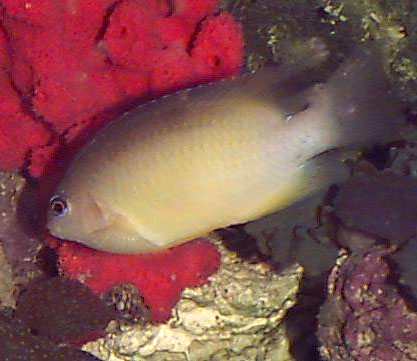| Pomacentridae (Damselfishes), subfamily: Microspathodontinae |
| 10 cm TL (male/unsexed) |
|
reef-associated; marine; depth range 0 - 10 m, non-migratory |
| Western Atlantic: including southern Florida (USA), Bermuda, and northern Gulf of Mexico to Brazil. |
|
Dorsal spines (total): 12-12; Dorsal soft rays (total): 13-16; Anal spines: 2-2; Anal soft rays: 12-14. Caudal fin slightly forked, with rounded lobes. Dark blue or brown above, yellow below, without obvious narrow vertical lines. Dark spot near back of dorsal fin well above its base becomes smaller in larger fish (Ref. 26938). |
| Adults occur in seagrass beds, coral or rocky reefs and sandy areas. Also found around mangrove shores and sponge beds; less common on flourishing coral reefs (Ref. 26938). They remain within 50 cm from the substrate. Adults feed on algae, polychaetes, amphipods, foraminiferans and gastropods while juveniles feed on harpacticoid copepods, nemerteans and polychaetes (Ref. 9626). Oviparous, distinct pairing during breeding (Ref. 205). Eggs are demersal and adhere to the substrate (Ref. 205). Males guard and aerate the eggs (Ref. 205). Caught incidentally in traps and small-meshed beach nets (Ref. 5217). |
|
Least Concern (LC); Date assessed: 15 November 2010 Ref. (130435)
|
| harmless |
|
Source and more info: www.fishbase.org. For personal, classroom, and other internal use only. Not for publication.

